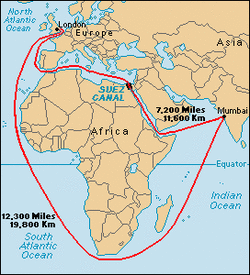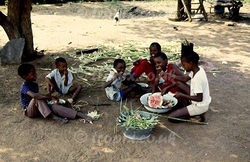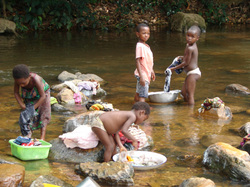Africa! Think about it. What thoughts come to your mind? For most children, visions of wild exotic animals pop up. Yes, elephants, lions, giraffes, and hippos are really neat creatures, and all can be found in different parts of Africa. But, there's so much more to Africa than that! If we open our minds, we just may learn something new, different, and interesting about this wonderful place.

Africa is the second-largest and second-most populous continent in the world with over two billion people. It's surrounded by water on all sides. It's northeast corner connects Africa to the world's largest continent of Asia by way of the Isthmus of Suez. The Suez Canal cuts through this Isthmus which is 101 miles wide. The Suez Canal allows convenient travel for ships carrying goods for trade to and from Africa, Europe, and other parts of the world. Ships are able to take a shorcut without having to sail completely around the southern tip of the African continent.
Question: Which route would you choose to travel from London to Mumbai?
http://en.wikipedia.org/wiki/Africa
Question: Which route would you choose to travel from London to Mumbai?
http://en.wikipedia.org/wiki/Africa
Regions and People of Africa

The continent of Africa varies widely in its climate and landscape. It's believed that Africa is the birthplace of the human species beween 5 and 8 million years ago. Geographers have divided Africa into five general regions as seen on this map, and refer to them as North, East, South, West and Central Africa. Each region contains several countries giving Africa a total of 54 countries in all. African culture is very diverse, changing from one country to another, and often within that same country different cultrues are found. People throughout the continent of Africa speak many different languages, practice many distinct religions, live in various types of dwellings, differ in their economic activities, celebrations and festivites as well.
www.africaguide.com/culture/index.htm
www.africaguide.com/culture/index.htm
"North Africa" The Sahara desert creates a cultural barrier separating the North part of the continent from the rest of Africa. The seafaring civilizations of the Mediterranean influenced the culture in this region. The Islamic religion has a significant influence in this area of the continent.
http://www.law.emory.edu/ifl/region/northafrica.html
http://www.law.emory.edu/ifl/region/northafrica.html
"East Africa" Some areas here are known for their large groups of wild animals. East Africa's climate is surprisingly cooler than you might expect, but very dry. Mount Kilimanjaro and Mount Kenya are found in this region and are Africa's tallest peaks and receive a lot of rainfall. Geography in East Africa is breath taking and very scenic. Today, tourism is a big part of the economy in the larger cities of East Africa.
http://traveltips.usatoday.com/culture-east-africa-17227.html
http://traveltips.usatoday.com/culture-east-africa-17227.html
"West and Central Africa" This region of Africa is most densly populated partly due to its abundant rainfall resulting in more productive farming. People here are able to make a better living than in the dryer African regions. The landscape varies from jungle rain forests, to desert, sandy beaches, fertile farm lands, wildlife parks, and grasslands. Tourism is not as popular in this region so visitors may be able to experience true African culture.
http://en.wikipedia.org/wiki/West_Africa
http://en.wikipedia.org/wiki/West_Africa
"South Africa" is known as the Rainbow Nation. The title refers to the incredible diversity of the people, from the Bushmen inhabitants to the people who migrated to this area over the years. Almost all the nations on Earth are represented in this diverse country. National parks and exotic animals are found here. A "safari" might be fun!
http://www.everyculture.com/Sa-Th/South-Africa.html
http://www.everyculture.com/Sa-Th/South-Africa.html
Festivities in Africa are common. Song and dance ceremonies are used to celebrate weddings, birthdays, crop harvests, religion, holidays, and just about anything the people in towns and villages feel is worth gathering together for, giving thanks and celebrating.
http://www.africaguide.com/culture/events.htm
http://www.africaguide.com/culture/events.htm

Before the people of Africia began to farm they ate mainly wild vegetables and some meat, fish, eggs, and seafood. As the climate changed and more of the country became the Sahara Desert fewer grasslands existed and it was harder to find food. This change caused more of the Africian people to become farmers. North Africa and Egypt people farmed wheat and barley that had been domesticated in West Asia. Pita bread and porridge became main stays. With more than 50 countries and thousands of cultures Africa's culinary traditions are as diverse as its terrain.
http://www.africanfoods.co.uk/african-food.html
http://www.africanfoods.co.uk/african-food.html
In African schools, children of all ages are often mixed together in the same classroom. Basic subjects are taught, with reading and writing topping the list. Technologies like computers are usually only found in larger African towns or cities. In poorer villages the children often have to share books.

SCHOOLS in AFRICA: In Central African Republic, over 70,000 children under age 12 will not go to school because there are not enough teachers to teach them. In most of Africa's countries, the government does not provide money for education. So for those children who live where teachers are available, many of their families cannot afford to pay school fees, and these children can not go to school. Many will end up such as the children in this picture, doing chores, or helping take care of sick relatives, and some having to work with their parents to help provide food and shelter for their family.
http://www.africanruralschools.org/
http://en.wikipedia.org/wiki/Education_in_Africa
FOOD for THOUGHT TIME: Hey kids, the next time you don't feel like you want to go to school, you might want to stop and think about the children in Africa that just wish they had the opportunity to go to school like you.
http://www.africanruralschools.org/
http://en.wikipedia.org/wiki/Education_in_Africa
FOOD for THOUGHT TIME: Hey kids, the next time you don't feel like you want to go to school, you might want to stop and think about the children in Africa that just wish they had the opportunity to go to school like you.
